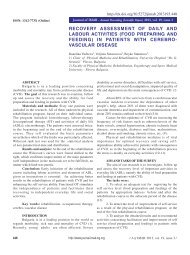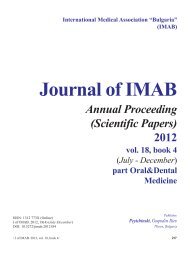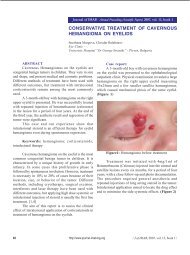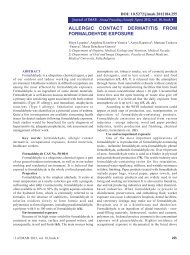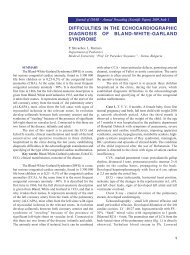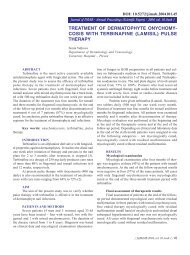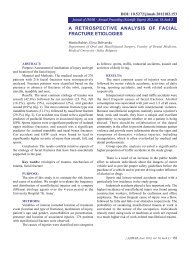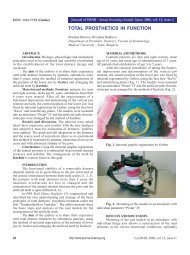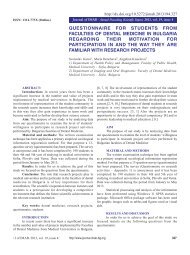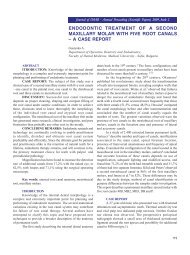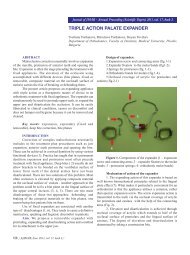MODERN CLASSIFICATION OF CUTANEOUS ... - Journal of IMAB
MODERN CLASSIFICATION OF CUTANEOUS ... - Journal of IMAB
MODERN CLASSIFICATION OF CUTANEOUS ... - Journal of IMAB
Create successful ePaper yourself
Turn your PDF publications into a flip-book with our unique Google optimized e-Paper software.
<strong>Journal</strong> <strong>of</strong> <strong>IMAB</strong> - Annual Proceeding (Scientific Papers) 2010, vol. 16, book 3<br />
<strong>MODERN</strong> <strong>CLASSIFICATION</strong> <strong>OF</strong> <strong>CUTANEOUS</strong><br />
PSEUDOLYMPHOMAS<br />
S. Shtilionova 1 , P.Drumeva 1 , M. Balabanova 2 , I. Krasnaliev 3<br />
1) Department <strong>of</strong> dermatology and venereology, Medical University - Varna<br />
2) Department <strong>of</strong> dermatology and venereology, Medical University - S<strong>of</strong>ia<br />
3) Department <strong>of</strong> pathology, Medical University - Varna<br />
SUMMARY<br />
Systematizing <strong>of</strong> different diseases and skin disorders<br />
is quite difficult. Different authors make classifications<br />
according to numerous criteria. Pseudolymphomas are<br />
reactive lymphocytic proliferations that appear in the skin and<br />
resemble a malignant lymphoma.<br />
Different classifications exist for cutaneous<br />
pseudolymphomas. The broadest classification differentiates<br />
them into 6 groups, but the most commonly used is the<br />
classification based on clinical and morphological criteria.<br />
According to the latest classification (1998), they are<br />
divided into cutaneous T-cell pseudolymphomas and -<br />
cutaneous B-cell pseudolymphomas.<br />
The evidence from the histopathological analysis is <strong>of</strong><br />
utmost important for the accurate diagnosis.<br />
Key words: Cutaneous pseudolymphomas,<br />
Classification<br />
Cutaneous pseudolymphomas are benign<br />
lymphoproliferating processes resembling malignant<br />
lymphomas clinically and histologically, in particular (1, 2).<br />
They present an accumulation <strong>of</strong> lymphocytes in response<br />
to various stimuli (infections, drugs, insect bites, etc.). This<br />
is a heterogeneous group <strong>of</strong> dermatoses with clinical<br />
manifestations varying from tumor-like nodes to flat cell<br />
infiltrates. Many authors divide them into pseudolymphomas<br />
in the narrow sense and pseudolymphomas in the broad<br />
sense <strong>of</strong> the term (4, 5). According to the type <strong>of</strong> the cell<br />
infiltrates, the cutaneous lymphomas are divided into T-cell,<br />
B-cell and mixed (3).<br />
Various classifications exist for cutaneous<br />
pseudolymphomas (1, 2, 3, 4). One <strong>of</strong> the relatively clearest<br />
and most frequently used in practice is Rijlaarsdam&<br />
Willemze’s classification based on clinical and morphological<br />
criteria.<br />
1. Cutaneous T-cell pseudolymphomas<br />
à) Primarily with stripe-like infiltration (the majority <strong>of</strong><br />
cases)<br />
Lymphomatoid drug eruption (most cases);<br />
Lymphomatoid contact dermatitis;<br />
Actinic reticuloid;<br />
Nodular scabies (individual cases);<br />
Idiopathic forms;<br />
Clonal cutaneous T-cell pseudolymphomas.<br />
b) Primarily with nodular infiltration (a small percentage<br />
<strong>of</strong> the cases)<br />
Drug-induced – mainly by anti-convulsive drugs<br />
(individual cases);<br />
Persistent nodules after insect bites;<br />
Nodular scabies (the majority <strong>of</strong> cases).<br />
2. Cutaneous B-cell pseudolymphomas (with nodular<br />
infiltration)<br />
Cutaneous lymphocytoma from Borrelia burgdorferi;<br />
Cutaneous lymphocytoma after antigens injection;<br />
Cutaneous lymphocytoma resulting from tattoo;<br />
Cutaneous lymphocytoma after Herpes zoster;<br />
Idiopathic forms;<br />
Clonal cutaneous B-cell pseudolymphomas.<br />
Another, also very common classification, is the one<br />
dividing them into 6 groups (Burg&Braun-Falco; Kerl&Smole)<br />
(5, 6):<br />
<strong>CLASSIFICATION</strong><br />
1. Infiltrations from non-lymphoid cells – tumor cells<br />
in neuroblastoma and in the tumor <strong>of</strong> Merkel’s cells can<br />
resemble a malignant lymphoma.<br />
2. Neoplasm rich in lymphocytes – for instance,<br />
cutaneous lymphadenoma (variant <strong>of</strong> trichoblastoma) can be<br />
so rich in lymphocytes that its epithelial component can be<br />
very difficult to identify.<br />
3. Stroma reaction in epithelial displasia and<br />
malignant neoplasms <strong>of</strong> the s<strong>of</strong>t tissues – lymphoid variants<br />
<strong>of</strong> actinic keratoses are well-known; neoplasms such as basal<br />
cell carcinoma and dermat<strong>of</strong>ibroma can cause extremely<br />
powerful stroma reactions, in which the primary neoplasm can<br />
be difficult to detect.<br />
4. Diseases which are not directly related to the skin<br />
– they comprise a long list and include Rosai-Dorfmann’s<br />
100 / J<strong>of</strong><strong>IMAB</strong> 2010, vol. 16, book 3 /
disease, Castleman’s disease, Kikuchi’s disease, inflammatory<br />
pseudotumor and malacoplacia.<br />
5. Classical dermatological diseases resembling<br />
cutaneous lymphoma – again the list is rather long, most<br />
frequently related to autoimmune diseases <strong>of</strong> the connective<br />
tissue. This group includes lychan sclerosus et atrificus,<br />
variants <strong>of</strong> lupus erythematosus, atypical lymphocyte lobular<br />
paniculitis, lymphomatoid dermatitis and lymphomatoid<br />
folliculitis.<br />
6. Specific cutaneous pseudolymphoma units – acral<br />
pseudolymphoma angiokeratoma in children (APACHE),<br />
palpable arciform migratory erythema, angiolymphoid<br />
hyperplasia with eosiniphilia and Kimura’s disease. The<br />
lymphomatoid papulosis is not classified under this group<br />
any more but falls into the group <strong>of</strong> the primary cutaneous<br />
lymphomas.<br />
DISCUSSION:<br />
The concept <strong>of</strong> cutaneous lymphomas provides the<br />
basis for the understanding and the identification <strong>of</strong> the<br />
benign and malignant cutaneous lymphoid infiltrations. Even<br />
following accurate histological investigations, many <strong>of</strong> the<br />
lymphoid infiltration processes remain unclearly defined as<br />
benign or malignant. The diagnosis <strong>of</strong> the cutaneous<br />
lymphoid infiltrations requires series <strong>of</strong> biopsies and<br />
examinations.<br />
REFERENCES:<br />
1. Crowson AN. Cutaneous<br />
pseudo-lymphoma: a review. Fitzpatrick’s<br />
J Clin Dermatol 1995; 3: 43-55.<br />
2. Brodell RT, Santa Cruz DJ.<br />
Cutaneous pseudolymphomas. Dermatol<br />
Clin. 1985 Oct;3(4):719-734. http://<br />
www.ncbi.nlm.nih.gov/pubmed/3916177<br />
3. Dorfman RF, Warnke R.<br />
Lympha-denopathy simulating the<br />
malignant lymphomas. Hum Pathol 1974<br />
Sep;5(5):519-550.<br />
http://<br />
www.ncbi.nlm.nih.gov/pubmed/4137045<br />
4. Gartman H. Generalisierte<br />
pseudo-lymphoma der haut. Hautarzt 1986;<br />
55: 166.<br />
5. Medeiros LJ, Picker LJ, Abel EA, et<br />
al. Cutaneous lymphoid hyperplasia.<br />
Immunologic characteristics and assessment<br />
<strong>of</strong> criteria recently proposed as diagnostic<br />
<strong>of</strong> malignant lymphoma. J Am Acad<br />
Dermatol 1989 Nov;21(5 Pt 1):929-942.<br />
http://www.ncbi.nlm.nih.gov/pubmed/<br />
2808829<br />
6. Ploysangam T, Breneman DL,<br />
Mutasim DF. Cutaneous pseudolymphomas.<br />
J Am Acad Dermatol 1998; 38:<br />
877-895; quiz 896-897.<br />
7. Burg G, Braun-Falco O. Cutaneous<br />
pseudolymphomas. In: Cutaneous<br />
lymphomas. Berlin: Springer -Verlag, 1983,<br />
415-464.<br />
8. Burg G, Kerl H, Schmoeckel C.<br />
Differentiation between malignant B-cell<br />
lymphomas and pseudolymphomas <strong>of</strong> the<br />
skin. J Dermatol Surg Oncol. 1984 Apr;<br />
10(4):271-275. http://<br />
www.ncbi.nlm.nih.gov/pubmed/6608539<br />
9. Kerl H, Smolle J. Classification <strong>of</strong><br />
cutaneous pseudolymphomas. Curr Probl<br />
Dermatol 1990; 19: 167-175.<br />
10. Rijlaarsdam JU, Bruynzeel DP, Vos<br />
W, Meijer CJ, Willemze R.<br />
Immunohistochemical studies <strong>of</strong><br />
lymphadenosis benigna cutis occurring in a<br />
tattoo. Am J Dermatopathol. 1988<br />
Dec;10(6):518-523.http://<br />
www.ncbi.nlm.nih.gov/pubmed/3218720<br />
11. Rijlaarsdam U, Scheffer E, Meijer<br />
CJ, Kruyswijk MR, Willemze R. Mycosis<br />
fungoides-like lesions associated with<br />
phenytoin and carbamazepine therapy. J<br />
Am Acad Dermatol 1991 Feb;24(2 Pt<br />
1):216-220. http://www.ncbi.nlm.nih.gov/<br />
pubmed/1826111<br />
12. Rijlaarsdam JU, Willemze R.<br />
Cutaneous pseudolymphomas:<br />
classifica-tion and differential diagnosis.<br />
Semin Dermatol 1994 Sep;13(3):187-196.<br />
http://www.ncbi.nlm.nih.gov/pubmed/<br />
7986687<br />
/ J<strong>of</strong><strong>IMAB</strong> 2010, vol. 16, book 3 / 101



